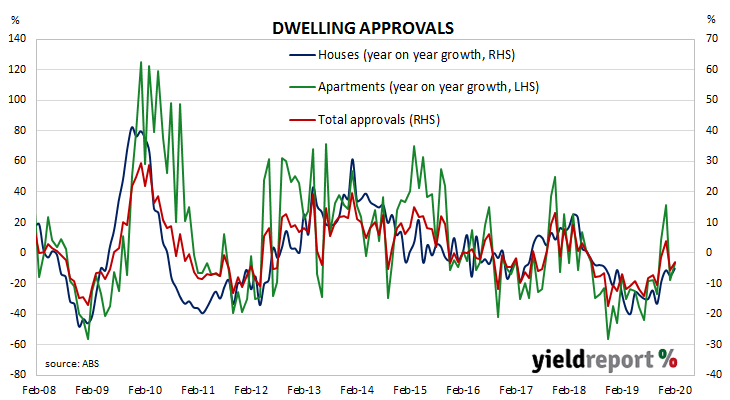Approvals for dwellings, that is apartments and houses, had been heading south since mid-2018. As an indicator of investor confidence, falling approvals represent a worrying signal, not just for the building sector but for the overall economy. Approval figures from November and December represented a substantial turnaround and the possibility of a recovery in 2020. While the latest numbers offer some suggestion of a rising trend, they are from a month untouched by the economic effects of the pandemic the world is currently facing.
The Australian Bureau of Statistics has released the latest figures from February and total residential approvals increased by 19.9% on a seasonally-adjusted basis, much higher than the +4.50% increase which had been expected and a substantial turnaround from January’s revised figure of -15.1%. On an annual basis, total approvals contracted by 5.8%, an improvement from January’s comparable figure of -11.1% after it was revised a little.
Westpac senior economist Matthew Hassan said, “Obviously we should ignore the headline figure; aside from the high-rise issue, many projects will be shelved or delayed as the social restriction measures impact activity and the substantive hit to the economy sees a pull-back in new building.” Australian government bond yields fell a little harder than their US counterparts had in overnight trading. By the end of the day, the 3-year ACGB yield had lost 5bps to 0.22%, the 10-year yield had dropped 8bps to 0.66% while the 20-year yield finished 12bps lower at 1.31%.
Australian government bond yields fell a little harder than their US counterparts had in overnight trading. By the end of the day, the 3-year ACGB yield had lost 5bps to 0.22%, the 10-year yield had dropped 8bps to 0.66% while the 20-year yield finished 12bps lower at 1.31%.
Prices of cash futures contracts moved to reflect a slight hardening of rate-cut expectations, although last month’s rate reductions by the RBA have almost ruled out any further cuts. By the end of the day, April contracts implied a rate cut down to zero as a 55% chance, up from the previous day’s 47%. May contracts also implied a 55% chance of such a move at that month’s RBA Board meeting. However, another rate reduction was not seen as being any more likely in later months of 2020; December contracts implied a 49% chance of a rate cut down to zero.
Approvals for new houses fell by 1.7% over the month, down from January’s revised figure of +0.7%. On a 12-month basis, house approvals were 5.1% lower than in February 2019.

